Categories
Select a new category
Autism Rates Higher in Women with PCOS & their Children
By Chelsea Toledo, M.A. on August 30, 2018
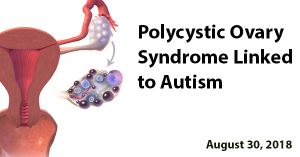
Background: Autism Spectrum Disorder (ASD) is about four times as likely to occur in males than in females. Because of that trend, scientists have suspected an association between ASD and testosterone. Elevated testosterone levels during gestation have been linked to an array of neurological conditions – including ASD – in both male and female children.
What’s New: A new study explored the association between ASD and polycystic ovary syndrome (PCOS), a condition in which women of reproductive age produce excess testosterone. The researchers examined existing data from the electronic health records of more than 60,000 women in the UK – 26,000 with PCOS and 1,000 with ASD – from 1990 to 2014. They also looked at the data from more than 8,000 children born to mothers with PCOS.
The researchers found:
- Women with ASD were more than twice as likely than their peers with typical development to have PCOS.
- Women with PCOS were nearly twice as likely than their peers without to condition to have ASD.
- The odds of having a child with ASD significantly increased among women with PCOS.
Why it’s important: This study suggests a connection between PCOS and ASD. Future research could lead to improved screening and treatment based on this finding.
Help me understand :
| Source(s) : |
| Tweet |
Gut Microorganisms Linked to Brain Function
By Chelsea Toledo, M.A. on January 18, 2018
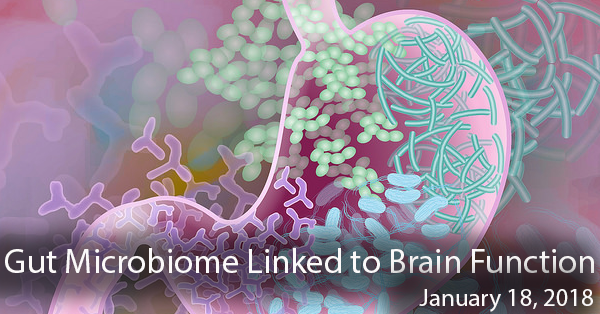
Background: Families of individuals who have Autism Spectrum Disorder, or ASD, often notice that they have atypical feeding patterns and gastrointestinal (GI) dysfunction, such as chronic constipation. A number of recent studies have reported significant number of children with having at least one GI symptom. Researchers are actively looking into the link between how gut function could alter brain function and behavior.
What’s New: A recent study in rats explored how different compositions of microorganisms in the gut — the “good bacteria” that aid in digestion — could affect brain function. The researchers fed 22 male rats one of four different diets: a balanced diet, a high-fat diet, a high-fiber diet, or a high-protein, low-carbohydrate diet. They collected and analyzed fecal samples before and three weeks after the experiment began, and studied the brains of the animals after three weeks on the diets using sophisticated imaging techniques.
The researchers found:
• Rats who ate the high-fiber and the high-protein diets had different functioning, when compared to the rats who ate the balanced diet, of the left frontal neocortex — a part of the brain associated with higher-order functions such as language and generation of motor commands.
• While those same differences weren’t observed in the brains of the rats who ate the high-fat diet, the scans revealed different functioning in several areas of the brain in that group, as compared to the rats who ate the balanced diet.
• Additional differences were observed in the brains of the rats who ate the high-protein diet, including distinct functioning of the corpus callosum, which connects the left and right sides of the brain and is associated with vision, eye movement, attention, and other functions.
• There were significant differences in the microorganisms present in the fecal matter of the rats from each diet group at the end of the experiment. When comparing the composition of the fecal matter taken at the beginning and the end of the experiment, the researchers could accurately predict which diet each rat had been assigned.
Why it’s important: While this study did not directly study ASD, it provides clues regarding the connection between GI symptoms and the cause of the disorder itself. Future studies could refine this link and potentially lay the groundwork for therapies targeting the gut.
Feature image depicts beneficial gut bacteria and is the work of Darryl Leja of the National Human Genome Research Institute, National Institutes of Health. The image has been adapted for this page.
Help me understand :
| Source(s) : |
| Tweet |
Autism Symptom Severity and Mothers’ Immune Response
By Chelsea Toledo, M.A. on December 22, 2017
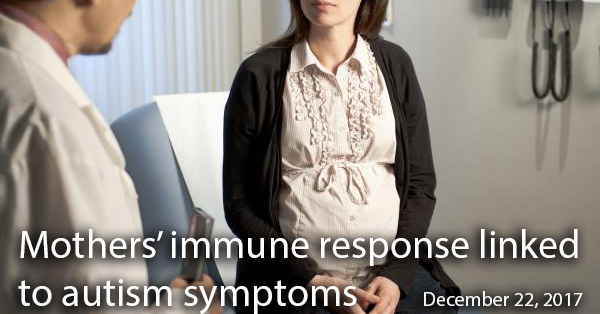
Background: What role the non-genetic factors play towards development of autism spectrum disorders (ASD) is a major concern. Several recent studies have suggested a link between illness or infection during pregnancy and the likelihood that the resulting child have ASD. However, few have established a link between mothers’ history of immune activity and the severity of social differences in the children who go on to receive a diagnosis.
What’s New: A recent retrospective study explored that potential link – comparing the severity of social symptoms in 220 children with ASD against their mothers’ histories of immune activity while pregnant. The researchers administered the Autism Diagnostic Observation Schedule-Generic (ADOS-G) to the children, and had their caregivers complete the Social Responsiveness Scale (SRS) to assess the severity of impairments in the following five areas: awareness, cognition, communication, motivation, and mannerisms. Finally, primary caregivers completed family medical histories as part of the study.
The researchers found:
- SRS scores were higher (indicating greater severity of social symptoms) in children whose mothers had a history of asthma and allergies.
- Symptoms were most severe in the areas of cognition and mannerisms for these children.
- Autoimmune conditions among mothers did not affect autism symptoms in children.
Why it’s important: This is the first study to correlate the severity of ASD social symptoms with maternal immune activity. Future studies following mothers and children over time could further probe this link to shed light on possible interventions.
Help me understand :
| Source(s) : |
| Tweet |
Researchers Probe Environmental Risk Factors for Autism
By Chelsea E. Toledo, M.A. on April 19, 2017
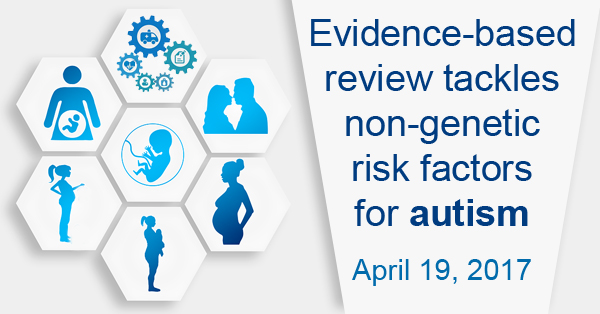
Background: Environmental risk factors comprise exposures and other biological features unrelated to DNA that are associated with an increased likelihood of developing a certain condition. In the case of Autism Spectrum Disorder (ASD), chemical exposures, birth complications, parental age and other factors encountered before or after birth have been identified as environmental risk factors.
What’s New: On March 17, 2017, the journal Molecular Autism published an evidence-based review of more than 100 potential environmental risk factors for ASD, ranking the strength of their association with ASD. The researchers looked at the evidence from 32 previously published meta-analyses and systemic reviews, each of those analyzing up to 25 studies on a single risk factor. From that extensive pool of data, they were able to conclude that:
- Advanced parental age and birth complications that cause trauma or oxygen deprivation are strongly related to a person’s risk of developing ASD. In addition, vitamin D deficiency appears to be common in children with ASD.
- Cesarean births, as well as obesity and diabetes during pregnancy, have a slight association with ASD in the resulting offspring.
- Vaccination, smoking during pregnancy, thimerosal exposure, and assisted reproductive technology most likely do not influence a person’s risk of developing ASD.
- Some heavy metals, such as mercury and lead, may have an association with ASD, and merit further investigation.
Why it’s important: This study helps to define which environmental factors for ASD merit a closer look from the research community. Future studies could further investigate those relationships to determine whether they do indeed influence the likelihood of ASD.
Help me understand :
| Source(s) : |
| Tweet |
New Genetics Study Finds Autism-Innate Immunity Link
By Shana R. Spindler, Ph.D. on January 18, 2017
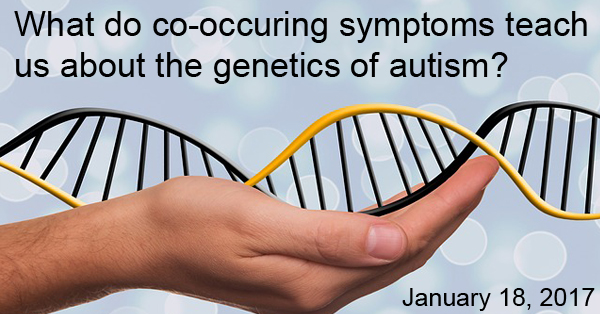
Background: Have you ever used one object in two ways? For example, you can use a spatula to flip an egg or swat a fly. The cells in our bodies do this all the time with the genes in our DNA. If something goes wrong with a gene, several problems in the body can occur. Think about the spatula. If the spatula factory accidentally shapes the flat surface like a spoon, you’ll have a hard time flipping eggs or smashing a fly. These are different activities, but the misshapen spatula affects both.
To learn more about the genetics behind autism spectrum disorder (ASD), researchers are looking at co-occurring symptoms that happen more frequently with autism than in the general population, such as seizures, infections, gastro-intestinal disorders, heart problems, and psychiatric disorders. The researchers hypothesize that these activities in the body may share a common gene or set of genes that, when disrupted, increase risk for ASD core symptoms and co-occurring symptoms at once.
What’s new: Researchers from Harvard Medical School and the Massachusetts Institute of Technology made an important link between ASD and the immune system by combining genetic data collected during other studies. Using a series of statistics calculations, the researchers found that genes involved in innate immunity were most likely to have problems across co-occurring conditions with ASD.
Innate immunity is your first line of defense to foreign invaders, like harmful bacteria. The researchers narrowed in on two parts of innate immunity that appear to be most significant. One is a group of proteins, called toll-like receptors, which help the body recognize microbes. The second includes chemokines, small signaling molecules that help attract nearby immune system cells.
Why it’s important: These results suggest a path forward to look at the genetic and environmental interactions behind some cases of autism. A common mechanism causing distinct symptoms may also aid in the development of targeted ASD therapies.
Help me understand :
| Source(s) : |
| Tweet |
Maternal Vitamin D Deficiency Linked to ASD-Traits in Kids
By Chelsea E. Toledo, M.A. on December 26, 2016
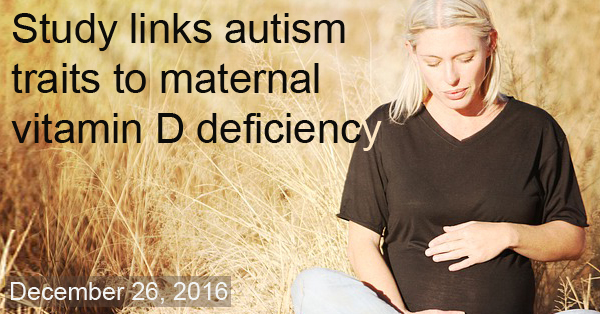
Background: Vitamin D is an important nutrient that not only aids the development and maintenance of the bones but also brain function. While most people in the developed world get sufficient vitamin D from regular sun exposure, deficiencies can arise in areas with long, cold winters or when people avoid the sun altogether. Studies have demonstrated that vitamin D deficiencies during pregnancy are associated with an increased risk of cognitive impairment and motor development in the resulting offspring.
What’s New: On November 29, 2016, Molecular Psychiatry published a study examining the relationship between vitamin D deficiencies in expecting mothers and the presence of behavior traits associated with Autism Spectrum Disorder, or ASD, among their children. The researchers assessed vitamin D levels in preserved blood samples taken from 4,229 mothers mid-way through their pregnancies, as well as from cord blood samples taken at birth. They then screened the resulting children (who, at the time of the study, averaged six years of age) for ASD traits using the Social Responsiveness Scale, or SRS. They found that children whose mothers were deficient in vitamin D both mid-way through pregnancy and at birth had higher average SRS scores – indicating the presence of ASD traits – than those whose mothers either had no deficiency or were only deficient at one point in time.
Why it’s important: This is the first study to identify a possible link between the level of vitamin D in a mother’s blood mid-way through her pregnancy and autism-related behaviors in the resulting child. Future studies could evaluate whether routine, inexpensive vitamin D supplementation during pregnancy could reduce the incidence of ASD in children.
Help me understand :
| Source(s) : |
| Tweet |
Infection During Pregnancy Increases Baby’s Autism Risk
By Chelsea E. Toledo, M.A. on December 13, 2016
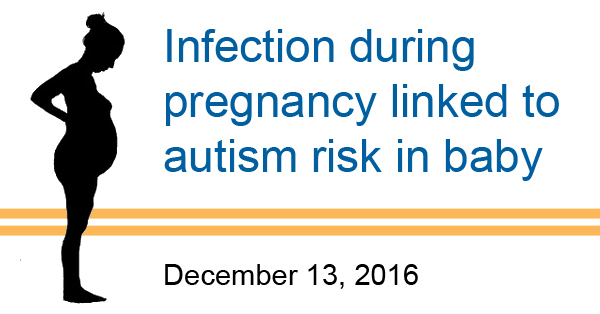
Background: While no singular cause has been identified for Autism Spectrum Disorder (ASD), research points to several risk factors. These include patterns in genetics as well as in external environmental conditions. One question under debate by researchers is whether infections during pregnancy could increase the risk of ASD in the resulting offspring. Multiple studies have investigated this theory, with conflicting results. To better understand a larger trend in smaller studies, researchers will sometimes conduct a meta-analysis – combining the results of the studies to create a bigger picture of the study effect in action. This statistical approach is especially useful when individual reports disagree in their conclusions.
What’s New: On June 6, 2016, Brain, Behavior, and Immunity published a meta-analysis of 15 studies examining the link between maternal infections and ASD risk. In total, the researchers evaluated data from more than 40,000 ASD cases studied between 2004 and 2015. Within the larger group, individual studies focused on viral, bacterial and fungal infections impacting women during all three trimesters of pregnancy. In combining all these data, the researchers observed a 12 percent increase in the risk of an ASD diagnosis in the offspring of mothers who experienced an infection during pregnancy. The effect was most pronounced among expectant mothers who were in their second trimester of pregnancy, whose infections led to hospitalization, and among those with bacterial infections of the skin or urinary tract. Viral infections during pregnancy and infections during the first trimester, however, were not associated with increased ASD risk.
Why it’s important: Following conflicting evidence in previous studies, this study suggests that babies born to mothers who experienced certain types of infections during pregnancy may in fact have a higher risk of being diagnosed with ASD. Of note, risk severity depended on the time of infection exposure (first, second or third semester) and the site of infection. With large enough sample sizes, future studies could more definitively prove or disprove that link – focusing especially on bacterial infections leading to hospitalization.
Help me understand :
| Source(s) : |
| Tweet |
Mother’s Body Mass Index Linked to Child’s Autism Risk
By Chelsea E. Toledo, M.A. on October 7, 2016
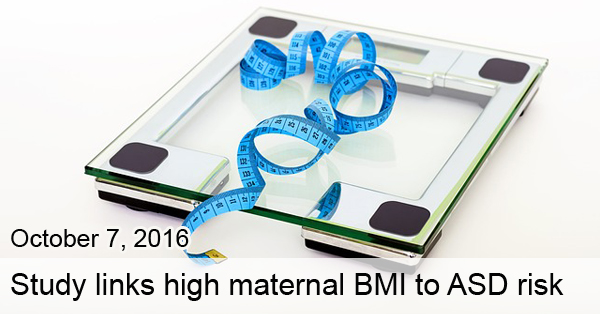
Background: Autism spectrum disorder, or ASD, is characterized by behavioral, communicative, and social differences that usually appear in early childhood. Research has pointed to both genetic and environmental factors underpinning the disorder. A number of environmental factors such as advanced parental age, exposure to toxicants, and maternal health conditions during pregnancy have been associated with a higher risk for having a child with autism.
What’s New: On September 30, 2016, Scientific Reports published a meta-analysis (an analysis of a series of studies) exploring whether mothers’ body mass index, or BMI, could be a risk factor for ASD. The researchers conducted a comprehensive review of seven previously published studies – examining data from more than 500,000 participants, 8,400 of whom had ASD. They found that mothers’ BMI before or during pregnancy was associated with the risk of ASD in offspring, with the highest risk among children of overweight (28%) and obese mothers (36%).
Why it’s important: This study suggests the recent increase in ASD may be related to an increase in obesity rates. Future studies could pinpoint the exact relationship between maternal BMI and ASD risk.
Help me understand :
| Source(s) : |
| Tweet |
ASD Risk Increases in Very Premature Babies
By Chelsea E. Toledo, M.A. on July 12, 2016
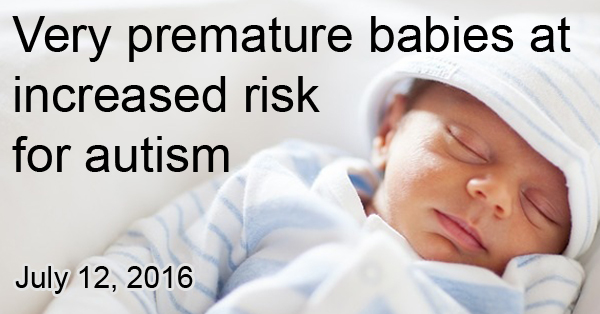
Background: Recent data from the U.S. Centers for Disease Control and Prevention shows that about 1 in 67 of 8-year-olds – or 1.5 percent – have an autism spectrum disorder (ASD) diagnosis. Boys are about four times more likely than girls to receive a diagnosis. The disorder, usually diagnosed during childhood, is characterized by social, behavioral and communicative differences.
What’s New: In a new study published May 25, 2016, researchers found that the prevalence of ASD was much higher – at about 7 percent – in children who were born before 27 weeks gestation. The risk of meeting ASD diagnostic criteria was higher the earlier a child was born.
The researchers performed an ASD screening on 889 10-year-olds who had been born at 23-27 weeks gestation, as well as follow-up diagnostic interviews on eligible children who met the screening criteria. They found that 61 children in the eligible sample met the diagnostic criteria for ASD, resulting in a prevalence of 7.1% in the entire group. The risk of meeting ASD diagnostic criteria increased the more prematurely children were born, with a prevalence of 15% in children born at 23-24 weeks gestation. About twice as many boys than girls met the diagnostic criteria for ASD.
Why it’s important: The overall prevalence of ASD was much higher in this sample of children born prematurely than in general population – with a much smaller ratio of boys to girls receiving diagnoses. This study suggests that children born prematurely should receive enhanced screening for ASD. Future studies could determine the underlying factors putting premature children at a greater risk.
Help me understand :
| Source(s) : |
| Tweet |
Mom’s Obesity May Up ASD Risk Due to Gut Bacteria
By Shana R. Spindler, PhD on June 22, 2016
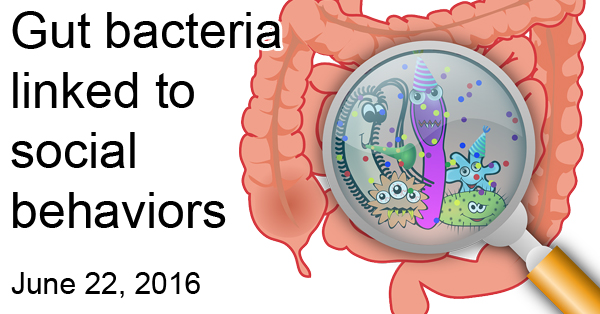
Background: Previous research has found an association between maternal obesity and an increased risk of autism spectrum disorder (ASD). A key question is how a mother’s obesity could affect her child’s risk of the disorder. By using animal models, researchers can study what factors are important for the association between maternal obesity and ASD.
What’s new: On June 16, 2016, the journal Cell published a study examining the link between obesity and autism risk using mice. Researchers put mice on a high-fat diet (or normal diet for controls) and studied the resulting pups’ behaviors. As expected, the pups in the high-fat group lacked several social behaviors typical to mice. The researchers found that a decreased diversity of gut bacteria due to high-fat diet affected the pup’s brain’s response to oxytocin, a chemical involved in social bonding. In a series of experiments, the researchers showed that exposure to gut bacteria from mice on normal diets helped the pups born to obese mice establish normal social behaviors.
Why it’s important: For the first time, researchers showed that increased autism risk from maternal obesity might be due to differences in gut bacteria, at least in mice. This study adds to the growing body of evidence that the health of your gut affects the workings of your brain, and part of a healthy gut includes a diverse community of beneficial bacteria. With additional research, the relative safety and availability of probiotics makes gut health an attractive target for autism therapy, or maybe even prevention.
Help me understand :
| Source(s) : |
| Tweet |
Prenatal Immune System Proteins in Mom linked to ASD
By Chelsea E. Toledo, M.A. on June 14, 2016
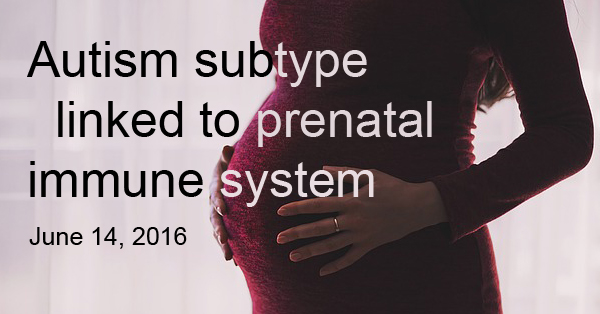
Background: Autism Spectrum Disorder (ASD) is characterized by social, behavioral and communicative differences and can be accompanied by intellectual disability. While genetics appear to play a strong role in the risk of having an ASD diagnosis, research has suggested that environmental factors – such as mothers’ immune activity during pregnancy – could factor into that risk, as well.
What’s New: On May 24, 2016, the journal Molecular Psychiatry published a study examining the relationship between a mother’s immune system biomarkers during pregnancy and children’s likelihood of having ASD. The researchers focused on mothers who had given blood samples as part of a public health study focused on early ASD indicators while pregnant, with a total of 1031 resulting children. In this group, 415 later received an ASD diagnosis, 188 had developmental delay without ASD, and 428 had typical development. The researchers further divided the ASD group into those with and without an accompanying intellectual disability and found that the mothers of the 184 children with both ASD and intellectual disability had higher levels of multiple immune-related proteins midway through the pregnancies than the mothers of children from all the other groups.
Why it’s important: The trends observed in proteins in expectant mothers’ blood proteins suggests that inflammation – the result of an immune response – may play a key role in the development of ASD with intellectual disability. Furthermore, these differences may help researchers to better understand sub-types of ASD.
Help me understand :
| Source(s) : |
| Tweet |
Diagnosis Differences in Adopted Population with ASD
By Shana R. Spindler, Ph.D. on March 15, 2016
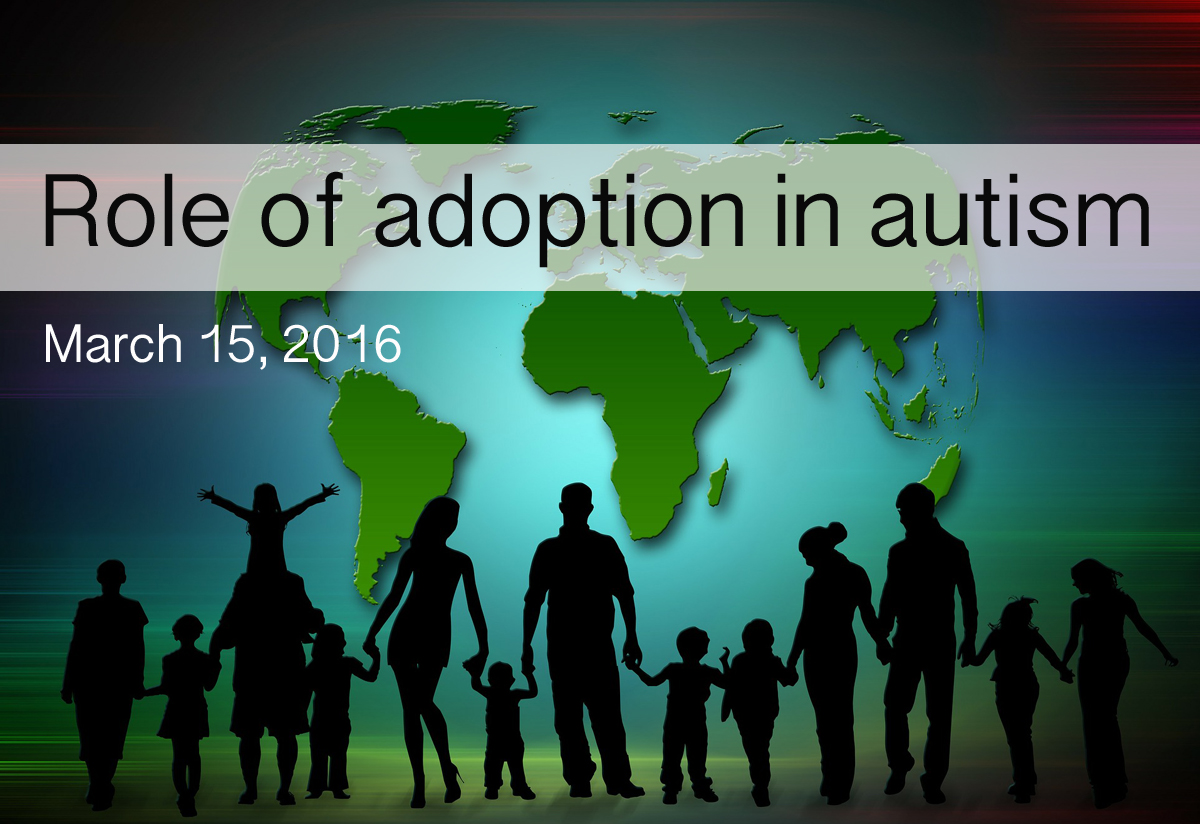
Background: Previous studies have linked adoption to general neurodevelopmental risks, but little is known about adoption as a risk factor for Autism Spectrum Disorder (ASD) specifically.
What’s new: In the February 2016 issue of the journal Pediatrics, researchers published a study exploring the differences in ASD diagnosis between adopted and non-adopted individuals. Using data in the Autism Speaks Autism Treatment Network, the researchers analyzed the cognitive ability, diagnosis, behavioral problems, and sleep habits for 163 adopted children and 5624 non-adopted children on the spectrum. They found that adopted children had increased:
- Attention problems
- Attention Deficit/Hyperactivity Disorder diagnosis
- Use of psychotropic medications
- Anxiety
- Depression
- Sleep problems
- Use of sleep medications
Why it’s important: This is the largest study of adopted individuals with autism to date. These results highlight the need for additional research in this unique subgroup, with a focus on factors associated with adoption—such as birth parent history, age at time of adoption, and history of institutionalization.
Help me understand :
| Source(s) : |
| Tweet |
Hormone Disorder in Mom Increases ASD Risk in Child
By Shana R. Spindler, Ph.D. on December 11, 2015
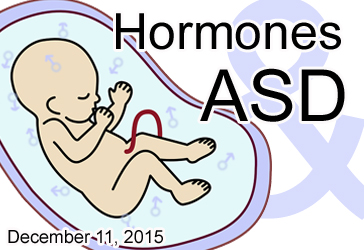
Background: Given the increasing recognition of autism spectrum disorder (ASD) in the last decade, researchers are investigating its biological causes with intense scrutiny. One line of research suggests that excess male sex hormones in the womb may affect brain development in the baby—creating what some term “extreme male brain.” Previous hormone studies, however, have been small in scale, and their findings have been inconsistent.
What’s new: On December 8, 2015, the journal Molecular Psychiatry published a study examining the role of hormone imbalance during pregnancy in ASD risk. The researchers examined Swedish medical records of 23,748 children with ASD aged 4 to 17 years and 208,796 matched controls. They found that women diagnosed with polycystic ovarian syndrome (PCOS)—a disorder in which the ovaries produce too much of the male sex hormone called androgen—are 59 percent more likely than women without PCOS to have a child with ASD.
Why it’s important: This study supports the need to further examine the role that hormone imbalance during pregnancy plays in ASD risk. Based on this study alone, we cannot determine if PCOS in the mother increases ASD risk due to hormone exposure in the womb or because common genetic pathways influence the development of both PCOS and ASD.
Help me understand :
| Source(s) : |
| Tweet |
Study Links Autism to Congenital Abnormalities
By Chelsea E. Toledo, M.A. on June 18, 2015
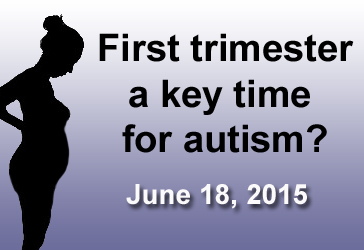
Background: Autism Spectrum Disorder (ASD) is characterized by differences in behavior, communication, and social interaction and has been linked to genetic and environmental risk factors. Studies haves suggested that congenital abnormalities such as cleft lips and palates—which begin to form early in pregnancy—are more common in children with ASD.
What’s New: On June 3, 2015, the Journal of Autism and Developmental Disorders published a study exploring the relationship between various congenital abnormalities and ASD in children with and without intellectual disabilities. The researchers examined the records of 17,695 Finnish children born between 1987 and 2000—4,441 with ASD and 934 with congenital abnormalities. They found that children with ASD were more likely to have congenital abnormalities of the eye, face, and neck, as well as the central nervous and musculoskeletal systems, development of which occurs during the first trimester. They also found that both the children with ASD and those with congenital abnormalities were more likely to have been born prematurely or at a low birth weight.
Why it’s important: This study suggests that—while ASD isn’t typically diagnosed until children are at least two years old—the underlying factors leading to the disorder may appear very early during gestation. Further research could illuminate the precise environmental, genetic, and epigenetic influences leading to ASD in the developing brain.
Help me understand :
| Source(s) : |
| Tweet |
Large-Scale Study Strongly Supports ASD, Parental Age Link
By Chelsea E. Toledo, M.A. on June 11, 2015
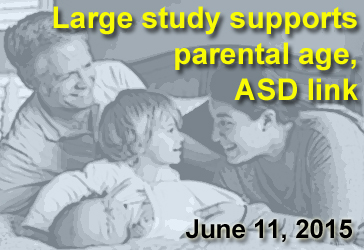
Background: In addition to the genes they pass on, parents’ age at the time of a child’s birth appears to influence ASD risk. Studies conducted over the past two decades have suggested that children of older parents have a higher risk of developing ASD.
What’s New: On June 9, 2015, a study in Molecular Psychiatry probed the role of parental age in ASD. The researchers examined health records from nearly six million children across five countries—with more than 30,000 ASD diagnoses. They found that the children born to mothers between the ages of 40 and 49 or to fathers older than 50 were more likely to have an ASD diagnosis than those with parents in their twenties. They also found an increased likelihood of ASD diagnosis in children born to mothers younger than 20 and in children whose parents were more than 10 years apart in age.
Why it’s important: This is the largest-ever multinational study looking at parental age and ASD. While the results appear to support the theory posited by previous studies—that genes inside sperm undergo mutations as men get older, contributing to ASD in the resulting offspring—future research could illuminate the biological roles of maternal age and age gaps between parents in relation to ASD.
Help me understand :
| Source(s) : |
| Tweet |
New Study Finds No Link Between Autism and MMR
By Chelsea E. Toledo, M.A. on April 22, 2015
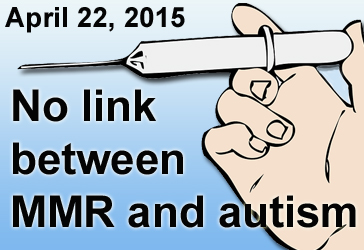
Background: Pediatricians recommend that children receive a vaccine to protect them from measles, mumps, and rubella (MMR) between 12 and 15 months of age, and then again between 4 and 6 years of age. However, the belief that these shots increase children’s risk of developing autism spectrum disorder (ASD) has contributed to a decrease in vaccination rates, threatening herd immunity.
What’s new: On April 21, 2015, the Journal of the American Medical Association published a large-scale study on the prevalence of ASD in vaccinated and unvaccinated children, all with older siblings—as children who already have a sibling with the disorder are considered to be at higher risk. The researchers looked at insurance claims data from 95,727 children between the ages of 0 to 5, 994 of whom had been diagnosed with ASD. They found that the risk of diagnosis was nearly identical for children who had been vaccinated versus those who had not. In addition, they determined that the risk of ASD did not increase following administration of MMR vaccines in children whose older siblings already had the disorder.
Why it’s important: This study adds to a wide body of research conducted over the past 15 years challenging the link between vaccines and ASD. The study also shed light on low vaccination rates among children whose older siblings had an ASD diagnosis—which the researchers attribute to the ongoing belief among affected families that vaccines led to their children’s ASD status.
Help me understand :
| Source(s) : |
| Tweet |
ASD Subset More Sensitive to Mitochondrial Stressors
By Shana R. Spindler, Ph.D. on March 4, 2015
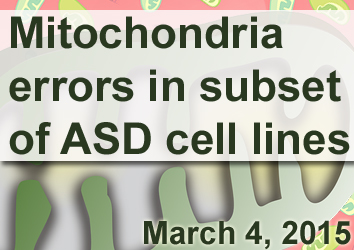
Background: Mitochondria, the microscopic powerhouses of cells, provide energy for cellular functions throughout the body and brain. Several studies have linked mitochondrial damage or dysfunction to complex neurological disorders, including autism. Both genetic mutations and environmental insults can disrupt mitochondrial function.
What’s new: On January 21, 2015, the Journal of Toxicology published a study looking at mitochondrial sensitivity to oxidative stress (when the body fails to eliminate damaging free radicals in the cell) in 19 children with autistic disorder (AD) and 19 control individuals. The researchers used a type of blood cell to make cell lines—where cells grow and replicate in a petri dish—for their study. All of the cells derived from AD children had a baseline level of mitochondrial dysfunction compared to controls. The researchers reported a subset of AD children (31 percent) whose cells exhibited remarkably abnormal mitochondrial function when exposed to ethylmercury, a chemical known to cause oxidative stress. The pretreatment of these cells with an antioxidant-boosting drug before ethylmercury exposure improved mitochondrial function.
Why it’s important: Ethylmercury is most famous for its role as a metabolite of thiomerisal, the controversial preservative in some vaccines. The take home message from this study is not that ethylmercury—or a vaccine—causes autism, but that a subset of autistic individuals may be more sensitive to environmental stressors, such as oxidative stress, due to abnormal mitochondria function in cells. The authors of the study are quick to point out that any assumptions made about ethylmercury exposure in the living person based on these in vitro cell results would be “overstating and unsubstantiated.” Why the mitochondria of these individuals is more sensitive, and how that may affect brain function, remains an open question.
Help me understand :
| Source(s) : |
| Tweet |
Tiny Air Pollutants During Pregnancy Increase ASD Risk
By Shana R. Spindler, PhD on January 30, 2015

Background: While genetic factors play a significant role in Autism Spectrum Disorder (ASD), several studies have pointed to air pollution as a potential environmental contributor to ASD risk.
What’s new: On December 18, 2014, the journal Environmental Health Perspectives featured a study exploring the correlation between ASD and air pollutant exposure before, during, and after pregnancy. The researchers found that exposure to particulate matter less than 2.5 micrometers in size—about 1/30 the width of a hair—during the third trimester significantly associated with an increased risk of autism. Larger particulate matter (2.5-10 micrometers) and exposure before pregnancy, during the first and second trimesters, and after pregnancy were not strongly linked to autism.
Why it’s important: Three recent studies found similar results. The strengths of the current study include a relatively large sample size (245 cases and 1522 controls), sampling from across the United States, timing of pollutant exposure, and a focus on specific particulate matter. The type of air pollution associated with ASD risk in this study is produced by all types of combustion, including car engines, power plants, and wood burning.
Help me understand :
| Source(s) : |
| Tweet |
Elevated Womb Hormone Levels Linked to ASD
By Chelsea E. Toledo, M.A. on July 21, 2014
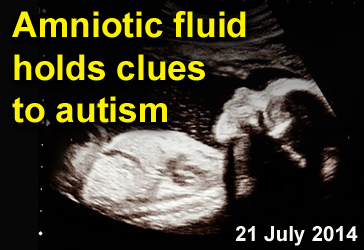
Background: Autism Spectrum Disorder (ASD) is usually detected in young children experiencing atypical development in the areas of communication, behavior, and social interaction. ASD is four times more common in boys than in girls. Researchers have long suspected that sex-related genetic factors may play a role in this disorder.
What’s new: On June 3, 2014, the journal Molecular Psychiatry published a study evaluating a possible link between ASD and the precursors to the male sex hormone testosterone in the amniotic fluid surrounding a developing fetus. The researchers analyzed amniotic fluid from mothers of boys born between 1993 and 1999 in a Danish cohort. In the samples from the 128 boys who later received an ASD diagnosis, the researchers found higher levels of male hormones–as well as a protein known to control hormone activity–than in the samples from the 217 controls.
Why it’s important: Using more than 19,000 amniotic fluid samples, scientists have shown a provocative link betweenelevated levels of steroid hormone and exposure in the womb to later development of ASD. However, further research is needed using different population samples to establish this link for any future clinical application.
Help me understand :
| Source(s) : |
| Tweet |
Pesticide Exposure Linked to Increased Risk of Autism
By Shana R. Spindler, Ph.D. on June 26, 2014
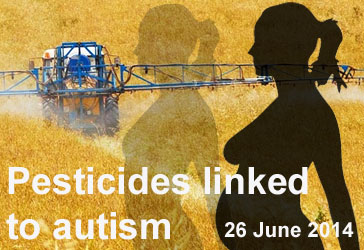
Background: Past studies have generated concerns regarding pesticide exposure during pregnancy and developmental delays in the child. But what role does pesticide exposure have, if any, in autism?
News Brief: Exposure to certain types of agricultural pesticides during or slightly before pregnancy may increase a woman’s risk of having a child with autism, according to a study published this month by University of California researchers. The team of scientists followed 970 participants as part of the Childhood Autism Risks from Genetics and Environment (CHARGE) Study. The researchers compared commercial pesticide application data with the addresses of study participants and found that those living near the application of organophosphates, a type of pesticide that affects how neurons function, were 60 percent more likely to have a child diagnosed with autism. Study participants living near the use of pyrethoid insecticides, a common type of insecticide that also affects insect nerve cells, showed increased risk for both autism and developmental delay.
Why it's important: It is important to recognize that this study shows correlation, not causation. The increased risk of autism in children whose mothers reside near pesticide application may or may not be due to the pesticides themselves, but other factors that are common in families who live near agricultural sites. Certainly, the study supports a closer examination of pesticide exposure and the ballooning rates of autism diagnosis.
Help me understand :
| Source(s) : |
| Tweet |
Soy-Based Infant Formula Doubles Risk of Seizures
By Shana R. Spindler, Ph.D. on April 22, 2014
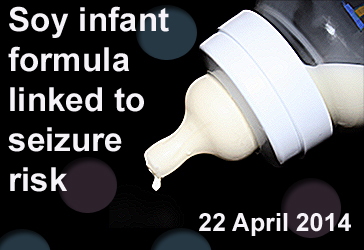
Background: Nearly 25 percent of infant formulas use soy protein, and many families rely on this non-dairy alternative during an infant’s first years of life. Some are concerned, however, that a component in soy called phytoestrogens may have an adverse impact on infants’ health by mimicking hormones in the body. Given the widespread use of soy-based formula, relatively few studies have addressed the effect of phytoestrogens on early childhood development.
What’s new: In 2013, Dr. Cara J. Westmark of the University of Wisconsin, Madison, reported that mice with neurological disease had more seizures while eating a soy-based diet. Now, she has expanded her studies to a human population. In the March 2014 issue of the online journal Plos One, Dr. Westmark reports that children with Autism Spectrum Disorder (ASD) are 2.6 times more likely to have febrile seizures—those associated with a high fever—and 2.1 times more likely to have epilepsy when given a soy-based infant formula. Even though the study was large, including 1,949 children, caution should be taken before making firm conclusions. The formula and seizure data were based on parental recall, and the study did not take into account the reasons for using soy formula nor the length of time on it.
Why it’s important: This study highlights the need to further investigate an association between phytoestrogen exposure early in life and an increased risk of seizures in the ASD population. The ability to decrease seizure risk through diet modification alone would be an important finding for those with ASD.
Help me understand :
| Source(s) : |
| Tweet |
Drug Sheds Light on Underlying Cause of Autism
By Shana R. Spindler, Ph.D. on February 11, 2014
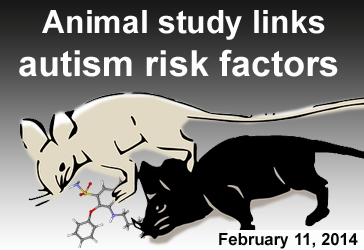
Background: With so many different genetic and environmental influences on autism, researchers are seeking a common link among risk factors. One thought is that different risk factors affect neuron function through a similar mechanism. For example, during birth there are maternal hormones that help the fetus deal with the stress of delivery and prepare the brain for post-natal development. Recent research suggests that understanding the dynamics of these hormones gives significant insight into newborn brain development.
What’s new: An animal study demonstrated that bumetanide, a commonly used diuretic drug, alters the effect of these maternal hormones. Researchers used two animal models of autism: one genetic and one drug-induced. In each model, the rodent’s progeny failed to undergo the typical brain changes in response to the labor hormone oxytocin. However, when the researchers administered bumetanide one day before delivery, the rodent’s offspring showed normal neuron function and fewer autism-like symptoms. According to the study, bumetanide enabled specific neurons to switch from an excitatory to an inhibitory state by changing chloride levels in the neuron.
Why it’s important: This study sheds light on autism’s underlying mechanism, linking both genetic and environmental risk factors to oxytocin’s effect on brain changes during birth. The finding, reported in the February 7, 2014, edition of Science magazine, supports a common mechanism for autism and paves the way for novel therapeutic strategies.
Help me understand :
| Source(s) : |
| Tweet |
Male Folate Intake Linked to ASD-Related Gene Expression
By Chelsea E. Toledo, M.A. on December 27, 2013
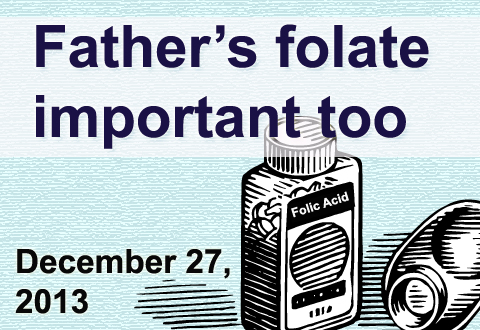
Background: Epigenetic modifications are those that alter DNA’s properties without changing the actual sequence. These alterations make it more or less likely that a gene will be expressed. Recently, researchers have been exploring whether epigenetic information, which is influenced by environmental factors, can be passed from parents to offspring.
What’s New: On December 10, 2013, a study in the journal Nature Communications evaluated the role of fathers’ intake of folate—a form of vitamin B—in their offspring’s development. Researchers exposed male mice to varying levels of folate from the time they were in utero; 49 received sufficient amounts of the nutrient, and 54 were folate-deficient. After breeding them, they found that the offspring of folate-deficient mice had greater epigenetic abnormalities in the genes related to diabetes, autism spectrum disorder (ASD), schizophrenia, and cancer.
Why it’s important: This study suggests that a father’s diet can influence the health of his resulting children, at least in mice. While further research is needed, the findings tout proper folate intake in men as a possible factor to help prevent ASD-related gene expression in children.
Help me understand :
| Source(s) : |
| Tweet |
Folic Acid Use in Pregnancy Linked to Lower Autism Risk
By Chelsea E. Toledo, M.A. on September 5, 2013
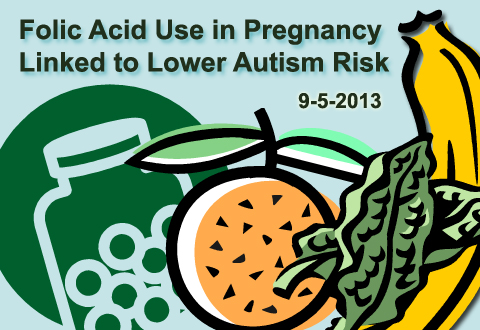
Background: Folic acid, a water-soluble B vitamin, is an ingredient in most prenatal supplements, and has been shown to decrease the risk for brain and spinal defects in developing embryos. Studies have also found correlations between folic acid use in very early pregnancy and lowered risk of severe language delay—suggesting the supplement may play a part in preventing neurodevelopmental disorders.
What’s New: On February 13, 2013, the Journal of the American Medical Association (JAMA) published an observational study evaluating the relationship between mothers’ folic acid exposure and the likelihood of their children to develop autism spectrum disorder (ASD). The researchers examined records of 85,176 children born between 2002 and 2008, who were participating in the Norwegian Mother and Child Study. They found that children whose mothers were unexposed to folic acid were about twice as likely (at a risk of 0.21%) to have a diagnosis of Autistic Disorder, the most severe form of autism, by 2012 than their counterparts whose mothers had taken the supplement.
Why it’s important: Although the findings do not establish that folic acid use prevents autism, this study supports the widespread recommendation for would-be mothers to begin taking the supplement before conception.
Help me understand :
| Source(s) : |
| Tweet |
Half-Sibling Study Reveals ASD Recurrence Risk Factors
By Shana R. Spindler, Ph.D. on August 23, 2013
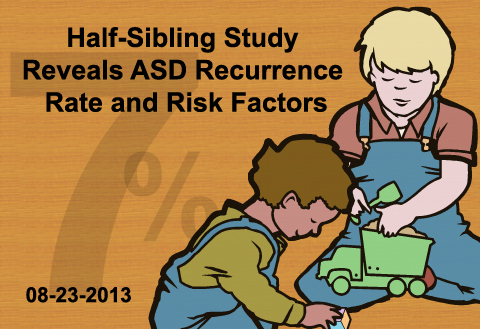
Background: What is the autism spectrum disorder (ASD) risk for a child who has an older sibling with ASD? Most researchers agree that a mix of genetics and environment affects risk, but they disagree on how much each factor plays a part. This makes risk prediction tricky. Previous reports indicate a wide range in ASD recurrence—when a second child has ASD.
What’s New: In a population-based study, researchers observed ASD recurrence rates in full- and half-siblings. The research team used records for all children, about 1.5 million, born in Denmark between January 1, 1980 and December 31, 2004.
The researchers report an overall recurrence risk of 7 percent. This is significantly higher than the population ASD risk of about 1.2 percent. For half-siblings sharing a father, recurrence rates were similar to the general population risk. In contrast, 2.4 percent of maternal half-siblings had ASD.
Why It’s Important: This study indicates a somewhat lower rate of recurrence than previously reported, a valuable finding for parents. A greater recurrence rate in maternal half-siblings suggests a key role for fetal environment in ASD risk. Also, the smaller recurrence risk in half-siblings, who share fewer genes, confirms a significant genetic contribution.
Help me understand :
| Source(s) : |
| Tweet |
Correlation Between Autism and Induced/Augmented Labor
By Shana R. Spindler, Ph.D. on August 15, 2013
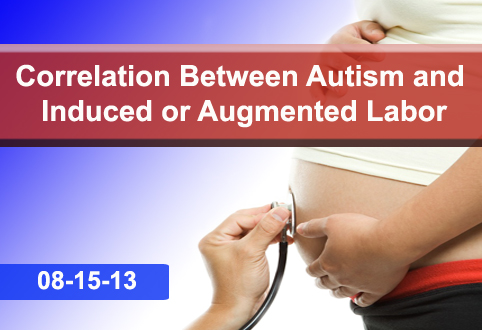
News Brief: A new study has caught the popular media’s attention. University of Michigan and Duke University researchers identified a correlation between autism and induced or augmented labor—the artificial start or enhancement of uterine contractions. The study, however, does not prove that autism is caused by medical interventions during labor. Rather, underlying issues that result in the need for induced or augmented labor may play a role in the development of autism.
While this study provides an interesting lead for future investigations, experts in the field emphasize that the study’s findings should not change current medical practice. For extensive coverage on this issue, please click the “Sources” buttons below.
Help me understand :
| Source(s) : |
| Tweet |
Study Supports Role of Maternal Autoantibodies in ASD
By Shana R. Spindler, Ph.D. on July 25, 2013
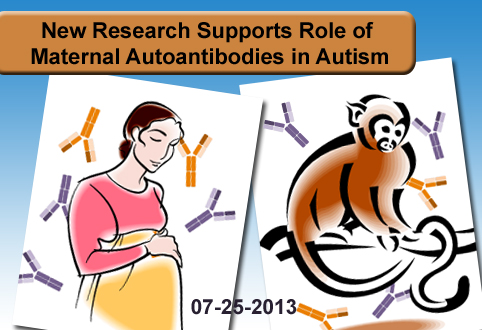
Background: Over the past several years, researchers have presented correlation between the existence of autoantibodies in mothers and an increased diagnosis rate of Autism Spectrum Disorder (ASD) in their children. Autoantibodies are Y-shaped proteins of the immune system that bind one or more of the body’s own proteins. Researchers hypothesize that autoantibodies can pass through the developing blood-brain barrier of a fetus and inhibit the function of proteins important for brain development.
What’s new: Two back-to-back studies published on July 9, 2013, in the journal Translational Psychiatry provide compelling support for the hypothesis that maternal autoantibodies contribute to ASD risk. The first study examined which proteins of the body are targeted by the autoantibodies. The researchers reported that each of the target proteins identified has a known role in neuron development and/or function. Mothers with certain combinations of autoantibodies were more likely to have children with stereotypical ASD behaviors than mothers who did not carry those same autoantibody combinations.
In the second study, researchers tested the causative role of autoantibodies in ASD by injecting purified antibodies from mothers who have children with ASD (called IgG-ASD) into pregnant rhesus monkeys. As a control, researchers injected purified antibodies from mothers of typically developing children into a separate group of pregnant monkeys. The monkeys born to mothers injected with IgG-ASD had more difficulty forming reciprocal social interactions than did the monkeys born to mothers injected with control IgG. Upon further examination, the researchers found that male monkeys born to mothers injected with IgG-ASD had increased white matter volume in the frontal, occipital, and parietal lobes of the brain.
Why it’s important: These two studies are remarkable for three important reasons: First, the fact that specific combinations of maternal autoantibodies are predictive of an ASD diagnosis in children suggests that autoantibodies are a promising biomarker candidate for some cases of autism. Second, while many studies are only correlative, the experiment in pregnant rhesus monkeys suggests a causative mechanism in the link between mothers’ autoantibodies and ASD in their children. Third, pharmacological intervention to block autoantibody activity offers new therapeutic opportunities for maternal autoantibody-related autism.
Help me understand :
| Source(s) : |
| Tweet |
Link Between Epilepsy Drug and ASD
By Stacy W. Kish on May 8, 2013
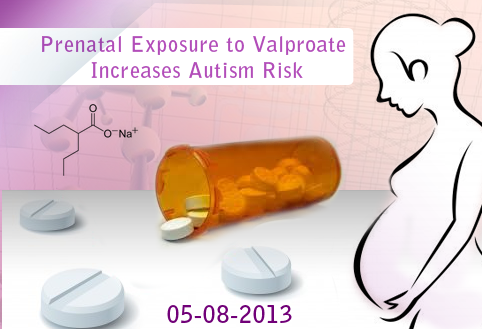
Background: Prenatal exposure to certain medications can affect embryonic and fetal development. For some women of childbearing age, the need to take medication before or during pregnancy is vital. Valproate, for example, is used to treat epilepsy and psychiatric conditions. Previous studies have drawn a tentative link between valproate use during pregnancy and an elevated autism spectrum disorder (ASD) risk in children.
What’s new: A new study published April 24, 2013 in the Journal of the American Medical Association evaluated ASD risk from prenatal exposure to valproate for all children born in Denmark between 1996 and 2006. Of the children with prenatal exposure to valproate (due to being born to mothers with epilepsy) approximately 4.1% received an ASD diagnoses with 2.9% receiving a diagnosis of severe childhood autism. For children born to mothers with epilepsy but not exposed to valproate in the womb, only 2.44% developed ASD and 1.02% developed severe childhood autism.
Why it’s important: This study suggests that prenatal exposure to valproate significantly increases a child’s risk of ASD and severe childhood autism. However, the study did not evaluate the associated risk of seizures during pregnancy (should the mother fail to take anti-seizure medication) to the development of autism in the offspring. The authors of the study suggest that women of childbearing age should discuss the use of valproate compared to alternate medications with their doctors.
Help me understand :
| Source(s) : |
| Tweet |
Antidepressant Use In Pregnancy Linked to Autism Risk
By Chelsea E. Toledo, M.A. on April 25, 2013
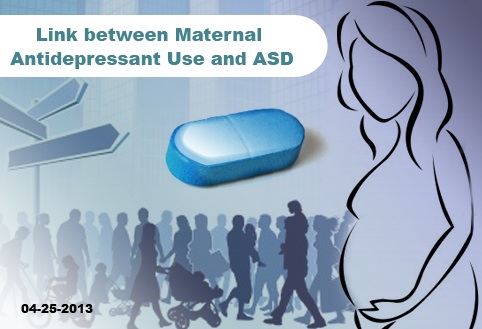
Background: In the past three decades, the rate of diagnosis for autism spectrum disorder (ASD) has increased dramatically—from one in 2,000 children to one in 88. While that uptick could be attributed to changes in diagnostic criteria, researchers are interested in identifying causal factors for ASD. Recent studies have suggested that depression or antidepressant use in parents could be associated with the development of ASD in resulting offspring.
What’s New: On April 19, 2013, British Medical Journal featured a study on parental depression and antidepressant use during pregnancy, with relation to ASD in children. Using publically available health records of 4,429 autistic individuals in Sweden, the researchers calculated the likelihood of an autism diagnosis as related to a family history of depression and maternal antidepressant use. Comparing the results to those of 43,277 controls, they determined that use of SSRIs and other antidepressants during pregnancy could account for about 1 percent of ASD cases.
Why it’s important: This is the second paper in two years to suggest a link between antidepressant use and ASD. However, because only a small fraction of ASD cases in the study appeared to be caused by maternal antidepressant intake, the increase in diagnoses is unlikely to be attributed to the drugs.
Help me understand :
| Source(s) : |
| Tweet |
Genomic “Hot Spots” May Influence ASD Risk
By Eric Larsen, Ph.D. on April 9, 2013
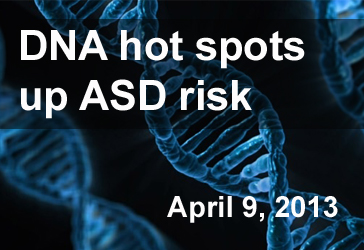
Background: De novo mutations that spontaneously arise in sperm or eggs and are subsequently transmitted from parents to children are thought to play a critical role in human disease, including autism spectrum disorder (ASD). In order to better assess the importance of de novo mutations in the genetics of ASD, it is necessary to understand what internal and external factors influence the onset of such variation.
What’s new: In a recent report in Cell, whole-genome sequencing was performed on ten pairs on monozygotic twins concordant with ASD and their parents. Whole-genome sequencing allows for the detection of genetic variation throughout the human genome, not only in genes. Sequencing of parental samples was performed to identify de novo mutations present in both monozygotic twins.
In agreement with recent ASD sequencing studies, paternal age was found to play a significant role in genome-wide variation, with the children of older fathers tending to have a greater number of de novo mutations. Rather than being randomly distributed throughout the genome, de novo mutations were more likely to be located in genomic “hot-spots” where the intrinsic properties of the DNA within these regions contributed to increased mutability. A number of genes and genomic regions that have been previously associated with ASD, such as the NRXN1 gene and the 15q11-q13 chromosomal region, were found to have elevated de novo mutation rates.
Why it’s important: These findings provide a better understanding of the factors that are responsible for ASD-associated de novo genetic variation. As DNA sequencing and analysis technology continues to progress, cataloguing ASD-linked “hot spots” in the human genome may aid in the development of screening and/or diagnostic genetic testing for autism.
Help me understand :
| Source(s) : |
| Tweet |
More Evidence Debunking Ties Between Vaccination & ASD
By Stacy W. Kish on April 4, 2013
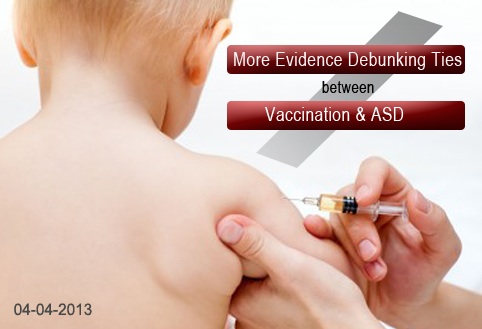
Background: After a rigorous review, the Institute of Medicine rejected the assertion that vaccinations cause autism spectrum disorder (ASD) in 2004. Despite this finding, many parents still express concern at the number and bundling of vaccinations administered to children in the first two years of life.
What’s new: Researchers at the Centers for Disease Control and Prevention conducted an intensive assessment of antibody-stimulating protein and polysaccharide content in vaccines administered to children between 1994 and 1999. These proteins and polysaccharides are molecules—known as antigens—that can stimulate an immune system response. The study, published in The Journal of Pediatrics, included 256 children with confirmed ASD and 752 control children. The researchers matched many variables between the two groups, including birth weight, maternal age, paternal age, education, and marital status.
Why it’s important: The researchers found that vaccinations are not a risk factor for developing ASD later in life, even when multiple vaccines are given at once. The results are relevant because the vaccinations children receive today contain a lower number of antigens than received by children before the year 2000, according to another study in the journal Pediatrics (Offit et al, 2002).
Help me understand :
| Source(s) : |
| Tweet |
Correlation between Heavy Metals and Autism Tightens
By Stacy W. Kish on March 21, 2013
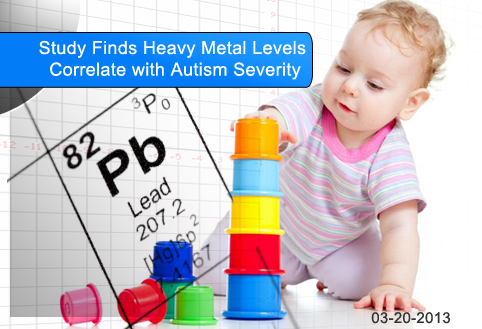
Background: Scientists have long questioned if toxic levels of heavy metals are a potential cause of autism. Eleveted concentration of heavy metals—like mercury, cadmium, and arsenic—in the body may result from increased exposure, increased absorption by the body, or the inability to excrete the toxic metals.
What’s new: A group of scientists at Arizona State University compared the level of 11 heavy metals in autistic and typical children to assess the link between heavy metals and autism. Researchers determined that autistic subjects in the study had higher levels of lead in the red blood cell samples and higher concentrations of thallium, tungsten, lead, and tin in urine samples. The study reported that greater levels of several heavy metals correlate with increased autism severity.
Why it’s important: While it is tempting to speculate that autism is caused by heavy metal exposure, this study only presents an interesting correlation between heavy metal levels in the body and the severity of autism. The findings from this study suggest that research to explore if heavy metal exposure is a contributing factor in autism is warranted, with the potential benefit of new prevention and therapy strategies.
Help me understand :
| Source(s) : |
| Tweet |
Mitochondrial DNA Damage Linked to Autism
By Stacy W. Kish on February 14, 2013
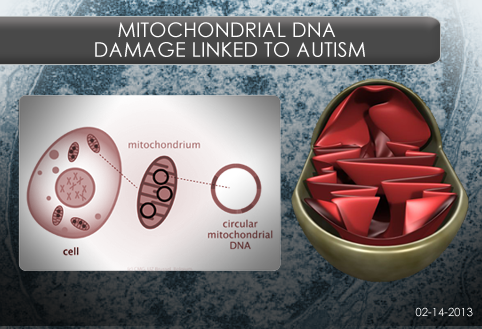
Background: Mitochondria, the powerhouses of the cell, have a set of DNA separate from the DNA in a cell’s nucleus. Some mitochondrial DNA codes for enzymes involved in energy conversion. During this conversion, reactive oxygen species (ROS) are produced that can cause damage to the cell, especially to the mitochondrial DNA. Few studies have examined mitochondrial DNA damage in children with Autism Spectrum Disorder (ASD), even though ROS production is reported to be higher in these children.
What’s new: A group of scientists at the University of California, Davis examined mitochondrial DNA (mtDNA) damage in autistic and typically developing children and their parents by direct sequencing of selected regions of their mitochondrial DNA. The participants were recruited from the CHildhood Autism Risk from Genes and Environment study (CHARGE).
The researchers found evidence of increased mtDNA damage in children with autism. The children appear to inherit mtDNA template damaged by oxidative stress from their mothers. In addition, the children may inherit a susceptibility to mtDNA deletions from their fathers, but fathers do not pass mtDNA to children.
Why it’s important: The amount of mtDNA damage in children with autism is similar to that of an older person. How environmental factors that contribute to increased mtDNA damage combine with genetic susceptibility to mtDNA deletions is an important area of investigation in the search for autism risk factors. This study provides a new line of evidence for the influence of mitochondrial DNA damage in autism.
Help me understand :
| Source(s) : |
| Tweet |
In Vitro Fertilization Not Likely To Increase ASD Risk
By Mark N. Ziats on February 1, 2013
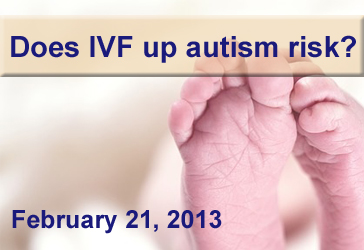
Background: Couples who cannot conceive children naturally may choose in vitro fertilization (IVF), where sperm fertilize an egg outside the body and doctors implant viable embryos into the woman. While some speculate that IVF conception may associate with development of Autism Spectrum Disorders (ASD), rigorous studies investigating the link are lacking.
What’s new: In a new study published in the journal Human Reproduction, researchers investigated the link between IVF and ASD using a Finnish registry with birth records of 20,000 children followed up to age 16. In the registry, approximately 1.51% of the children who eventually developed ASD or a related syndrome (e.g. Asperger’s) were conceived by IVF. This was not significantly increased from the 1.38% of children who were conceived via IVF but did not go on to develop ASD, after controlling for age, sex, place of birth, socioeconomic status, mother’s age, and birth number.
Why it’s important: A previous 2011 study in Denmark investigating the association between assisted conception and autism found no significant correlation between IVF and the later development of autism. This latest report supports those findings, and while additional studies are needed to confirm these results, the current evidence suggests that IVF treatments are not likely to increase ASD risk.
Help me understand :
| Source(s) : |
| Tweet |
Scientists Explore Relationship between ASD and ID
By Stacy W. Kish on January 23, 2013
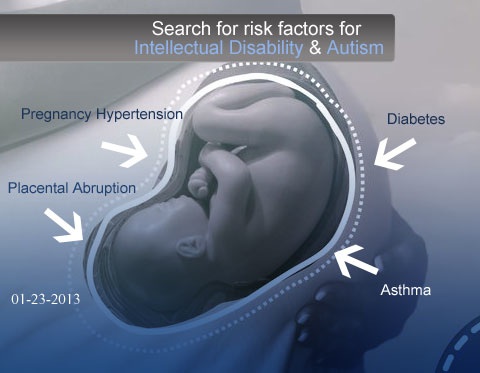
Background: Patients diagnosed with Autism Spectrum Disorder (ASD) and Intellectual Disability (ID) often exhibit similar symptoms—impaired communications, developmental delay, repetitive behaviors, and social difficulties. Scientists remain uncertain how genetic or environmental factors contribute to each condition.
What’s new: A group of scientists at Telethon Institute for Child Health Research in Perth, Australia examined a variety of factors that occur before and shortly after childbirth that could place a child on a trajectory toward ASD or ID. They compared patients with ID, ASD with ID, and ASD without ID. Their results associate ASD with maternal or placental infection, which may affect early brain development. Whereas, the researchers found a stronger correlation to other pregnancy factors, such as diabetes, pregnancy hypertension, asthma, urinary tract infections, and placental abruption, in the development of ID. Interestingly, poor fetal growth correlated with ID as well as ASD with ID, but not ASD without ID.
Why it’s important: This work differentiates some of the prenatal factors that may associate with each disorder and highlights the importance of differentiating ASDs with and without ID when investigating ASD causes, preventative measures, and targeted therapies.
Help me understand :
| Source(s) : |
| Tweet |
Autism Risk Linked to Differences in Infant Play
By Chelsea E. Toledo, M.A. on November 29, 2012
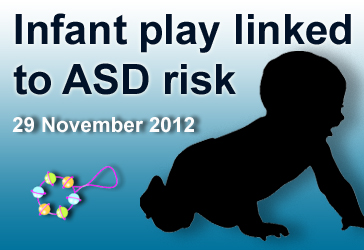
Background: Research has shown that infants with an autistic sibling are at an increased risk for developing Autism Spectrum Disorder (ASD). Researchers also know that the behaviors which are atypical in children with ASD--including communication and social interaction--have roots in the behaviors displayed in infancy. Lesser understood is how infants' behaviors evolve as they undergo typical development versus the emergence of ASD.
What’s New: In a report published in the print and online editions of Autism, researchers evaluated how infants at high versus low risk for ASD explored objects. They observed 31 infants--15 defined as "high risk" because they had an autistic sibling--at 6 and 9 months of age as they played with rattles. The researchers concluded that, while none of the high-risk infants went on to receive an ASD diagnosis, they did display significant differences from the low-risk group in time they spent looking at and mouthing the rattles. However, the time high- and low-risk infants spent touching the rattles with their hands was largely the same.
Why it’s important: The way infants handle objects can affect their skills later on; for instance, making sounds while chewing a rattle can help infants practice consonant sounds. Because ASD is associated with atypical language and cognition, a better understanding of the precursor behaviors for those abilities in infants teaches scientists more about how the disorder manifests in toddlers and older children.
Help me understand :
| Source(s) : |
| Tweet |
Gestational Immune Activity and Autism Link Unclear
By Chelsea E. Toledo, M.A. on November 21, 2012
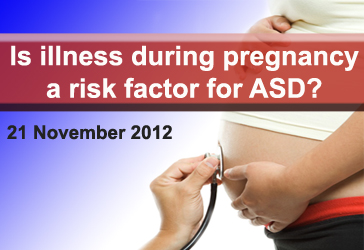
Background: Some scientists and medical professionals believe that changed activity of a mother’s immune system during pregnancy is linked to atypical social skills, communication and repetitive behaviors in her resulting offspring. These traits are characteristic of Autism Spectrum Disorder (ASD), but previous studies have yet to prove a definite association between infection during pregnancy and the development of ASD in humans.
What’s New: In a report published in the online version of Pediatrics, investigators evaluated the likelihood that infections, fever and antibiotic use during pregnancy were risk factors for ASD in the developing child. Studying the medical records of almost 100,000 Danish children born between 1997 and 2003, the researchers determined how many of the 1000 children diagnosed with ASD had been exposed to the potential risk factors, which are related to immune activity in pregnant mothers. They concluded that—while ASD was more common in children whose mothers reported having influenza, prolonged fever or certain antibiotics in their systems while pregnant—the suspected link between increased immune activity of pregnant mothers and ASD in their resulting children was not strong.
Why it’s important: This exploratory study tested multiple hypotheses at once—whether infections, fever or antibiotics in pregnant women can lead to autism in their developing children. That study technique could be to blame for some of the seemingly positive associations between ASD and increased gestational immunity, so further research testing one risk factor at a time is needed to answer the question definitively.
Help me understand :
| Source(s) : |
| Tweet |
Study Finds Confounding Factors in ASD Prevalence
By Stacy W. Kish on November 14, 2012
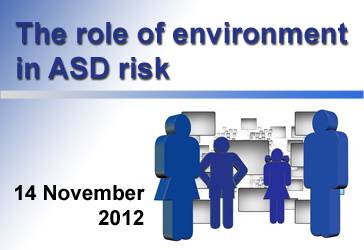
Background: Can where you live increase a child’s risk of autism? Previous studies have tried to link spatially distributed environmental factors, like air pollution or agriculture pesticides, to autism risk. However, the spatial distribution of confounding factors, such maternal education level, have made it difficult to narrow environmental factors that could place a child at risk for autism.
What’s new: In a new study published in Environmental Health, researchers examined the geographic distribution of ASD patients in North Carolina. They linked birth records to surveillance data obtained from the Autism and Developmental Disabilities Monitoring (ADDM) Network. The researchers used a generalized additive model (GAM) to estimate ASD prevalence in the area. Using the model, the researchers found that geographic variability of ASD prevalence declined when the model accounted for predictive and diagnostic factors—those factors that increase ASD risk or make a parent more likely to recognize ASD symptoms—such as year of birth, race/ethnicity, level of the mother’s education, smoking habits during pregnancy, plurality, and maternal age. The diminished variability limited the researcher’s ability to identify an environmental factor of concern.
Why it’s important: Unlike previous work, this study used GAM, which better adjusts individual risk factors when modeling ASD prevalence in the area. This study underscores the importance of understanding confounding factors to interpret geographic patterns properly when examining the role of the environment in ASD risk.
Help me understand :
| Source(s) : |
| Tweet |
Researchers Examine Newborn Immune System in ASD Risk
By Stacy W. Kish on October 26, 2012
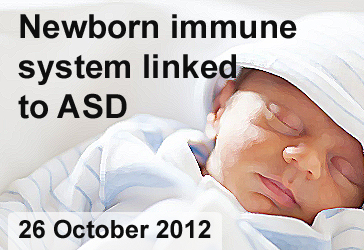
Background: Humans receive protection from their mothers (passive immunity) to resist infectious organisms before and shortly after birth. This protection, however, only protects the infant for several weeks. The baby’s immune system quickly activates after birth to begin defending the body from pathogens and resist infections. Previous work revealed that children and adults diagnosed with Autism Spectrum Disorder (ASD) had abnormal levels of immune molecules in their blood.
What’s new: A recent study published in the Journal of Neuroimmunology examined the blood samples of more than 300 newborns later diagnosed with autism and more than 700 control patients. The researchers measured the level of 16 cell signaling molecules, called cytokines, that contribute to the immune system. Their work showed that nine of the molecules were lower (in particular T helper 1 and T helper 2) in the autistic patients as newborns and adults compared to the controls. The samples were collected between 1982 and 2000 in Denmark.
Why it’s important: Previous work has shown that autistic patients have increased levels of certain circulating immune molecules known as cytokines. This study, however, is the first to show a decreased level of select cytokines. The discrepancy may be due to study complications, such as diagnostic inconsistencies or sample degradation. A mechanism that depresses immune function specifically in the newborn remains unclear.
Help me understand :
| Source(s) : |
| Tweet |
Amygdala Size, Repetitive Behaviors Linked to Immune Cells
By Shana R. Spindler, Ph.D. on October 24, 2012
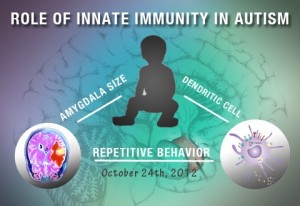
Background: Previous research has shown that Autism Spectrum Disorder (ASD) correlates with abnormal activation and function of the innate immune system, a population of cells that provides an initial defense against foreign organisms. How innate immune system regulation is linked to ASD is an active area of investigation.
What’s New: Researchers at the MIND Institute (University of California, Davis) reported in the 17 October online edition of Brain, Behavior, and Immunity that dendritic cells—an important cell population within the innate immune system—are significantly increased in children with ASD. The researchers examined 57 children, ages 2-3 years, and 29 age-matched controls. For both groups, the researchers found a positive correlation between circulating dendritic cell number and size—as measured by MRI—of the amygdala, a brain structure involved in processing emotional events and memory. Additionally, the researchers report that children with ASD who have increased circulating dendritic cells also have more pronounced repetitive behaviors, according to ADOS assessment. For children with a regressive form of ASD, the researchers found a positive association with a specific sub-population of dendritic cells.
Why It’s Important: This is the first study to show a correlation between innate immune system regulation, structural changes in a brain region called the amygdala, and behavioral severity. Little is known about the mechanisms that link the immune system to ASD pathogenesis. This study supports the hypothesis that innate immune system dysfunction may affect the development and/or maintenance of brain structures that control behaviors associated with ASD.
Help me understand :
| Source(s) : |
| Tweet |
Paternal Age and Autism Link Holds Up in Aruba
By Chelsea Toledo, M.A. on September 28, 2012
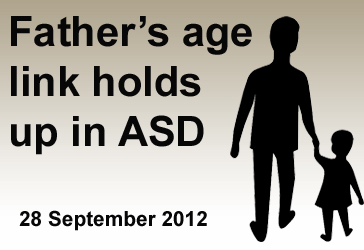
Background: Several major studies have demonstrated that children with Autism Spectrum Disorder (ASD) are more likely to be born to older fathers. However, the majority of that research has been carried out in high-income countries such as the United States, Western Australia and the United Kingdom. Research in less industrialized settings could shed light on the level to which social and cultural factors contribute to the prevalence of ASD within a geographical area.
What’s New: In the September 2012 version of PLOS ONE, researchers report that Aruban children with ASD are more than twice as likely to have been born to a father over age 30 than their peers without the disorder. Studying publically available medical records, they determined that the risk of having a child with ASD was about twice as high for fathers in their thirties and two and a half time as high for fathers in their forties than the risk for younger fathers. These findings are consistent with those from more industrialized nations and demonstrate that the link between paternal age and risk for ASD is present in a country with lower income, where the economy and demographics are in transition.
Why it’s important: While it is understood that the risk of having an autistic child increases with the age of the father, the explanation for that association is not yet clear. Because fathers in Aruba have diverse reasons for delayed parenting, the study effectively rules out the theory that men with unperceivable autism tend to have children later and pass on those genes.
Help me understand :
| Source(s) : |
| Tweet |
Older Fathers May Increase Risk of Autism
By Catherine Croft Swanwick, Ph.D. on August 24, 2012
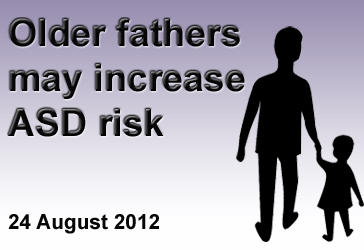
Background: Previous epidemiological studies have reported an association between older parents and increased risk of Autism Spectrum Disorders (ASD).
What’s New: A recent study quantified the risk of ASD as parents age. Scientists studied genetic material from families whose children developed ASD or schizophrenia despite no family history of these disorders, allowing them to search for mutations which occur spontaneously, or de novo, in embryos after they are inherited.
The research team found that DNA inherited from fathers undergoes more mutation as their age at the time of conception increases. They estimate that DNA inherited from a 20-year-old father undergoes approximately 25 de novo mutations, and that this number increases by two for every additional year of the father’s age. Unlike other studies, they found no correlation between maternal age and ASD.
Why It’s Important: Hundreds of de novo mutations have been linked with ASD. This study shows how quickly the rate of de novo mutations increases as fathers age. The average age of fathers at time of conception is steadily increasing worldwide, suggesting that advanced paternal age may play a role in the rising prevalence of ASD.
Help me understand :
| Source(s) : |
| Tweet |
Maternal Infection May Lead to Autism, Immune Dysfunction
By Catherine Croft Swanwick, Ph.D. on August 3, 2012
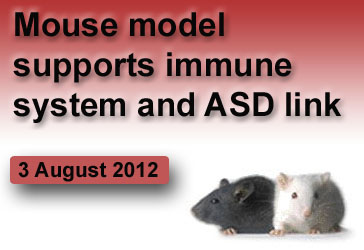
Background: Maternal infection is a known risk factor for ASD. Various types of maternal infections associate with ASD according to different strengths of evidence: rubella strongly associates with ASD based on numerous scientific publications and animal models, influenza moderately associates with ASD due to conflicting results, and cytomegalovirus weakly associates with ASD with reports from <10 scientific papers.
In order to generate mice displaying ASD symptoms, scientists can mimic maternal infection by activating the immune system of their pregnant mothers. This maternal immune activation (MIA) model is often used to explore neurobiological mechanisms underlying ASD.
What’s New: Scientists used the maternal infection model of ASD (also known as the MIA model) to examine the role of the immune system in ASD. In addition to exhibiting ASD symptoms, mice born to MIA mothers showed problems with their immune systems. Bone marrow transplants from healthy mice both 1) restored their immune system function and 2) reduced ASD symptoms such as repetitive and anxiety-like behaviors.
Why it’s Important: This evidence suggests a link between the immune system and ASD behaviors. Many humans with ASD also possess immune system problems. Future research will most likely focus on the role of the immune system in ASD and whether immunological treatments will help reduce ASD symptoms.
Help me understand :
| Source(s) : |
| Tweet |
Both Genetics and Environment Important in Autism
By Shana R. Spindler, Ph.D. on January 22, 2012
Overview: Autism susceptibility has a significant environmental component, according to a study published in the November issue of the Archives of General Psychiatry.
Background: Researchers from across California identified twin pairs with at least one twin having autism spectrum disorder (ASD) to investigate the relative influence of genes versus environment on the development of ASD. In total, the researchers examined 192 pairs of twins, including 54 identical twins and 138 fraternal twins, one of the largest studies of its kind.
What's New: The researchers completed a statistical analysis comparing the rate of autism diagnosis for identical versus fraternal pairs. Using their analysis, they estimated that 38 percent of ASD cases are due to genetic factors, and 58 percent are due to environmental factors. However, the study’s findings were not conclusive given that the statistical analysis did not take into account genetic susceptibility to the environment.
Why it's important: According to the report’s authors, future studies that examine the association between genetics and environment will likely enhance our understanding of autism.
Help me understand :
| Source(s) : |
| Tweet |
Autism Risk Higher for Smaller Twin
By Shana R. Spindler, Ph.D. on January 10, 2012
Overview: When twins are born at markedly different weights, the smaller of the set is three times more likely to develop autism than his or her sibling, report researchers in the December online issue of Psychological Medicine.
Background: Earlier this year, a study using single births found a correlation between low birth weight and increased autism risk. Northwestern University researchers have now studied both identical and fraternal twins to further examine the autism and low birth weight correlation.
What's new: In the study, the correlation between lower birth weight and an increased risk of developing autism held true whether the researchers were comparing identical or fraternal twins.
Why it's important: The researchers' findings suggest that environmental factors, rather than genetic, are the basis for the birth weight-associated risk difference.
Help me understand :
| Source(s) : |
| Tweet |
Antidepressant Exposure May Increase ASD Risk
By Shana R. Spindler, Ph.D. on November 11, 2011
Overview: Researchers at the University of Mississippi Medical Center examined the effect of antidepressant use during fetal development in rat pups.
Background: A common target for antidepressant medications, Serotonin, is a neurotransmitter that contributes to feelings of happiness—but serotonin also plays an important role during early brain development.
What's new: The researchers report in the Proceedings of the National Academy of Sciences online edition that rat pups exposed to antidepressants shortly before and after birth exhibit abnormal brain features and social behaviors similar to those seen in children with autism.
Why it's important: The study’s findings support the need to examine if human exposure to antidepressants during fetal development is a risk factor for the development of autism.
Help me understand :
| Source(s) : |
| Tweet |
Low Birthweight Linked to Autism
By Shana R. Spindler, Ph.D. on November 10, 2011
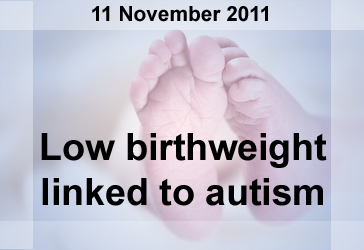
Background: According to a new study, children born at a low birthweight may be at an increased risk for developing autism. Researchers at the University of Pennsylvania School of Nursing and School of Medicine followed over 1100 infants who weighed less than 4.4lbs at birth to the age of 21 by periodic assessment.
What's new: The group reported in the Oct 17 online edition of Pediatrics that an estimated 5% of children born under 4.4lbs will go on to develop Autism Spectrum Disorder (ASD). The researchers followed low-birthweight infants to age 21, likely capturing both severe and mild forms of ASD.
Why it's important: According to the Centers for Disease Control, 1% of 8-year-old children have ASD, indicating that a low birthweight may increase a child’s risk of developing the disorder by five-fold.
Help me understand :
| Source(s) : |
| Tweet |

